Unlock the vibrant flavors of the Middle East with this incredibly creamy and utterly delicious Lebanese Baba Ganoush dip. Crafted from humble ingredients, this iconic appetizer boasts a smoky depth and a velvety texture that will tantalize your taste buds. Often likened to its cousin, hummus, but distinguished by its star ingredient – roasted eggplant – Baba Ganoush is a versatile delight perfect for any occasion. Whether served as a sophisticated side dip alongside succulent grilled meats, a wholesome spread for warm pita bread, or a refreshing accompaniment to crisp, healthy vegetables, this dip promises a burst of authentic Mediterranean taste in every scoop. Prepare to impress your family and friends with a homemade version that far surpasses any store-bought alternative, all while being surprisingly simple to make.

What is Baba Ganoush? A Dive into this Classic Lebanese Dip
Baba Ganoush, also widely recognized as Baba Ghanouj, is an exquisite and traditional Lebanese appetizer that has captivated palates far beyond its origins. While it shares the beloved dip format with hummus, its distinctive character comes from its primary ingredient: fire-roasted or oven-baked eggplants. Unlike hummus, which relies on chickpeas for its base, Baba Ganoush achieves its unique flavor and texture through the smoky, tender flesh of eggplants, blended with fresh lemon juice, rich tahini, aromatic garlic, and a touch of salt. This harmonious blend creates a dip that is simultaneously earthy, bright, and deeply satisfying.
The name “Baba Ganoush” itself is thought to mean “pampered daddy” or “spoiled father,” an endearing nod to its luxurious texture and delightful taste, suggesting it’s so good, even a pampered person would enjoy it without having to chew. This culinary masterpiece is not just a staple in Lebanese cuisine but is cherished across the Middle East and has gained immense popularity worldwide. Its ability to complement a vast array of dishes, from simple vegetable platters to elaborate main courses, makes it an indispensable part of any mezze spread. Learning to make authentic Baba Ganoush is an invitation to explore the rich culinary heritage of Lebanon and bring a taste of its vibrant culture into your home kitchen.
If you’d like to explore more delightful Lebanese recipes that my family adores and frequently prepares, here are a few highly recommended options: Lebanese Spinach Pies, a comforting and flavorful Lebanese Lentil Soup, and my incredibly simple yet delicious Easy Lebanese Hummus Recipe. Each of these recipes is super easy to follow and guarantees a truly delicious outcome!
Why This Baba Ganoush Recipe Will Become Your Go-To
There are countless reasons why this particular Baba Ganoush recipe stands out and is destined to become a favorite in your kitchen. It’s more than just a dip; it’s an experience that delivers on flavor, health, and convenience. Here’s why you’ll fall in love with it:
- Explosively Flavorful: You might be surprised at the depth of flavor a simple eggplant can possess when prepared correctly. The magic happens during the roasting process, which caramelizes the eggplant and infuses it with an incredible smoky sweetness. This technique unlocks a profound umami and robust flavor profile that elevates the dip far beyond what you might expect from an eggplant-based dish, making it truly irresistible.
- A Universal Crowd-Pleaser: This recipe is thoughtfully crafted to cater to a wide range of dietary needs and preferences, making it the ultimate inclusive dish. It is naturally vegan-friendly, completely gluten-free, and entirely dairy-free. This means whether you’re hosting a diverse group of friends, planning a family gathering, or simply looking for a healthy snack option, this creamy eggplant dip is guaranteed to be a hit with everyone at the table, ensuring no one feels left out.
- Effortless Preparation, No Special Equipment: Forget about needing a fancy outdoor grill, a traditional wood-burning oven, or any specialized culinary gadgets. This Baba Ganoush recipe is designed for maximum accessibility, utilizing a standard oven to achieve perfectly roasted eggplants. This method makes it incredibly easy for anyone, regardless of their kitchen setup, to prepare an authentic and delicious baba ghanouj dip right in their own home.
- Remarkably Healthy and Nutritious: Beyond its incredible taste, this dip is a powerhouse of nutrition. It contains no added sugars, relying instead on the natural sweetness of the roasted eggplant. Eggplants themselves are an excellent source of essential vitamins, minerals, and dietary fiber, all while being commendably low in calories. Paired with the healthy fats and protein from tahini, this Baba Ganoush offers a wholesome and guilt-free indulgence that supports a balanced diet.
- Incredibly Versatile: This isn’t just a dip; it’s a culinary chameleon. Enjoy it traditionally with warm pita bread, crunchy fresh vegetables, or as a side to grilled chicken or lamb. But don’t stop there! Spread it on sandwiches and wraps for an added burst of flavor, or use it as a base for vibrant bowls. Its versatility ensures you’ll find endless ways to incorporate this delicious and healthy dip into your meals.
Essential Baba Ganoush Ingredients for Authentic Flavor
Creating an authentic and incredibly delicious Lebanese Baba Ganoush relies on selecting quality ingredients and understanding their role in the final flavor and texture. Each component plays a crucial part in achieving that perfect creamy, smoky, and tangy balance.
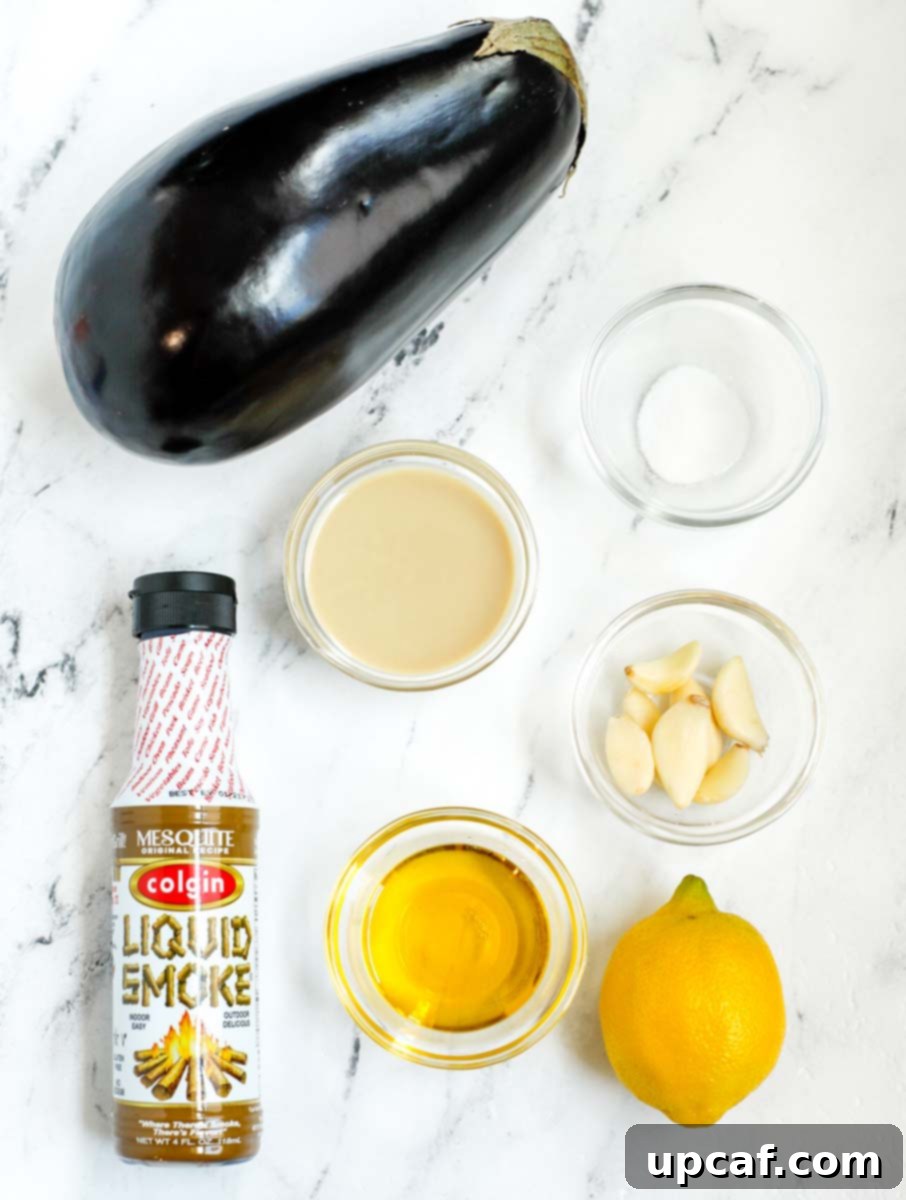
- Eggplants: The Heart of the Dip: The choice of eggplant is paramount. Look for medium to large-sized eggplants that possess a smooth, glossy skin completely free of blemishes or soft spots. The color should be a uniform, deep purple. When you pick up an eggplant, it should feel surprisingly heavy for its size, indicating good moisture content. Avoid eggplants that feel light or spongy, as these may be older and more bitter. The quality of your eggplant directly impacts the smoky flavor and creamy texture of your Baba Ganoush.
- Tahini: The Creamy Binder: Tahini, a paste made from finely ground toasted sesame seeds, is indispensable for authentic Baba Ganoush. It acts as a natural emulsifier, binding the ingredients together while imparting a rich, nutty, and slightly bitter creaminess that is characteristic of the dip. Choose a good quality, runny tahini for the best results; if it’s too thick, it might make your dip pasty. Stir it well before measuring.
- Fresh Lemon Juice: The Zesty Brightness: Always opt for freshly squeezed lemon juice. Bottled lemon juice often contains preservatives and lacks the vibrant, natural acidity that truly makes the flavors of this dip “pop.” The fresh citrus brightness cuts through the richness of the tahini and eggplant, balancing the overall profile and adding a refreshing tang.
- Garlic: The Aromatic Foundation: Fresh garlic is absolutely essential for a pungent and flavorful Baba Ganoush. Minced fresh garlic provides a sharp, aromatic kick that complements the smoky eggplant beautifully. Avoid using pre-minced garlic from a jar if possible, as it can often have a slightly acidic or off-flavor due to preservation, which can overpower the delicate balance of the dip.
- Salt: The Flavor Enhancer: A good pinch of salt is crucial for seasoning and bringing all the flavors together. Start with a smaller amount and adjust to your preference, tasting as you go. Remember, a little bit of salt goes a long way in enhancing the natural deliciousness of the ingredients.
- Liquid Smoke (Optional): For an Extra Smoky Punch: Since we’re roasting the eggplants in an oven rather than over an open flame, a few drops of liquid smoke can dramatically enhance that authentic smoky flavor that defines classic Baba Ganoush. This is entirely optional, but it’s a fantastic trick to achieve a deeper, more traditional taste without needing a grill. Start with just 2-3 drops and add more gradually to avoid overpowering the dip.
How To Make the Perfect Oven-Roasted Baba Ganoush
Creating this delicious Lebanese Baba Ganoush at home is a straightforward process, primarily involving roasting the eggplant to perfection and then blending it with the other vibrant ingredients. Follow these detailed steps to achieve a dip that’s bursting with flavor and boasts an irresistibly creamy texture.
- Step 1: Roasting the Eggplant for Maximum Flavor: Begin by preheating your oven to a robust 425°F (220°C). Prepare your eggplants by piercing them several times with a fork or a knife. This allows steam to escape during cooking, preventing them from bursting and ensuring they cook evenly. Place the pierced eggplants directly onto a non-stick baking sheet. Roast them in the preheated oven for approximately 40-45 minutes. The exact cooking time may vary based on the size of your eggplants, so look for them to be completely fork-tender and deeply softened when pressed. The skin should be wrinkled and slightly charred in places, indicating that the smoky flavor has developed beautifully.
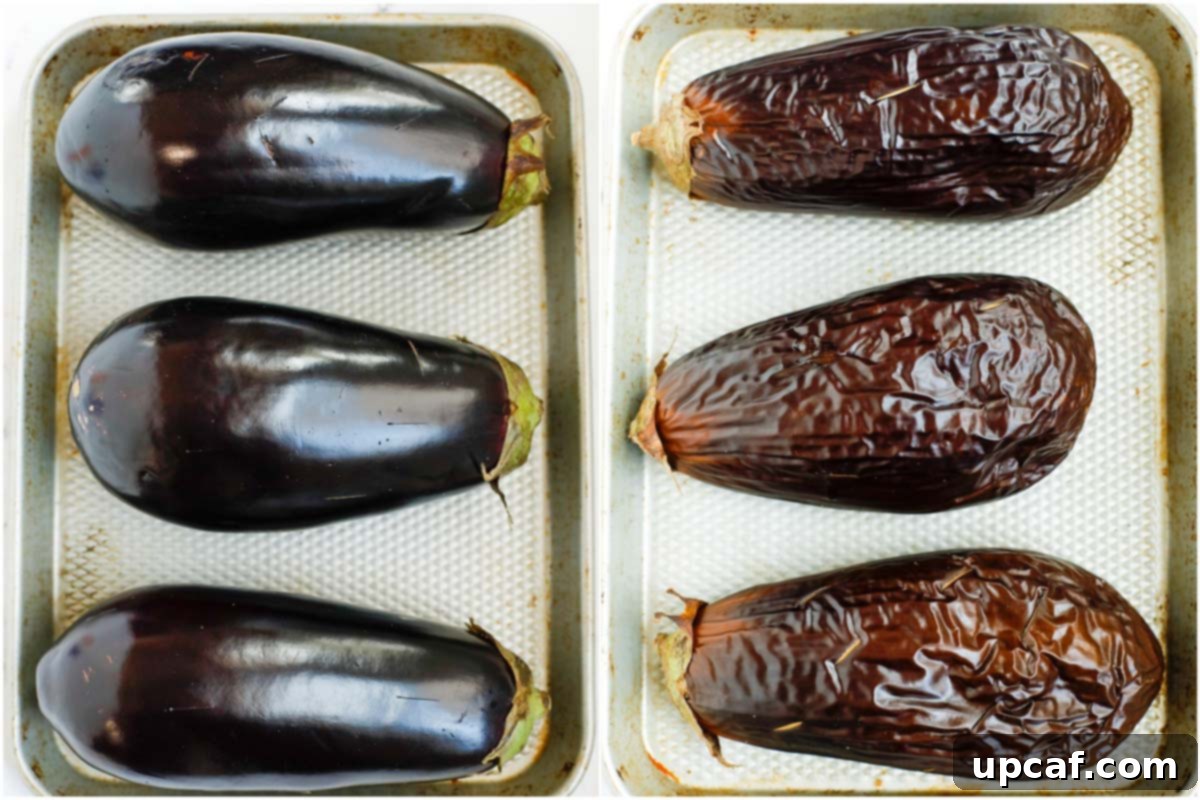
- Step 2: Cooling the Roasted Eggplants: Once the eggplants are thoroughly cooked and removed from the oven, immediately slice them down the center lengthwise, exposing their soft, cooked flesh. This crucial step helps them cool down much faster and also allows any excess moisture to evaporate, preventing a watery dip. Let them cool completely to room temperature. This can take 30 minutes to an hour. If you’re short on time, you can place them cut-side down on a wire rack over a bowl to help drain excess liquid while cooling.
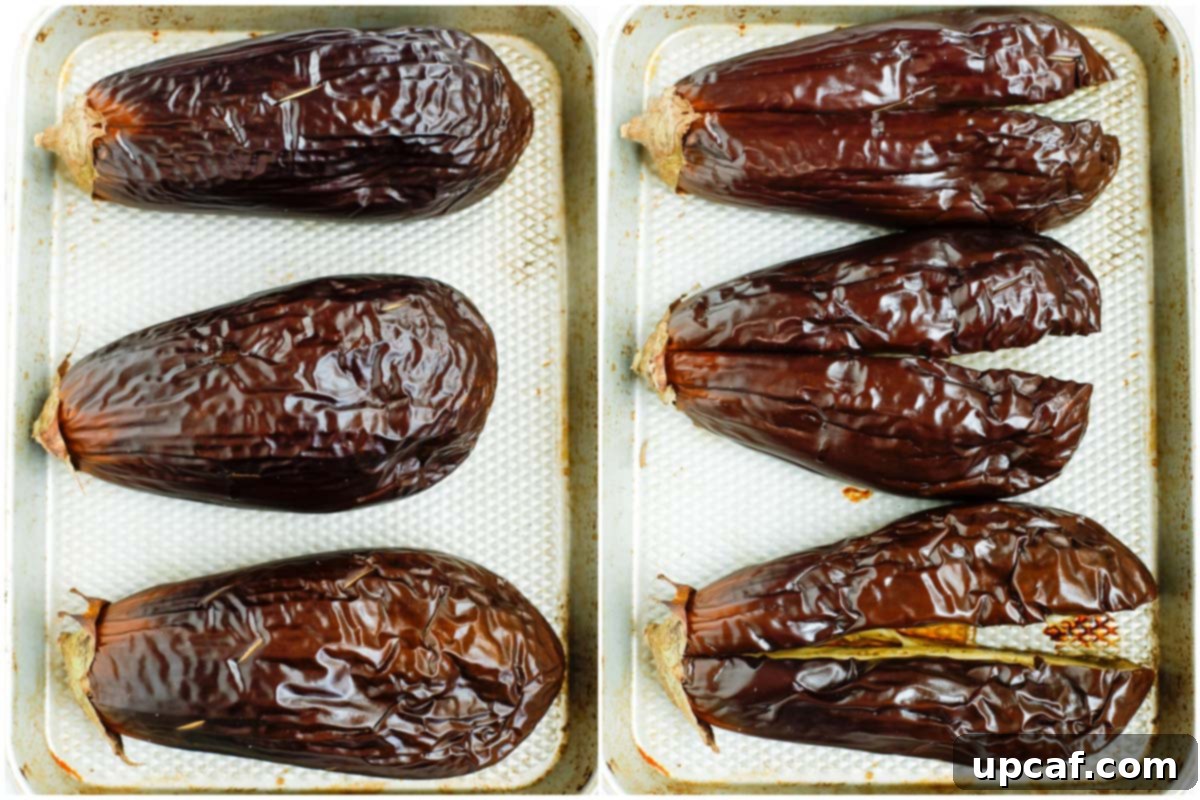
- Step 3: Scooping Out the Tender Flesh: Once the roasted eggplants are completely cool to the touch, use a spoon to carefully scoop out the tender, smoky flesh from inside the skin. Discard the skin, as it can be tough and bitter. Ensure you get as much of the soft interior as possible, leaving behind any hard or uncooked bits near the stem. For an even smoother consistency, you might consider gently pressing the scooped flesh through a fine-mesh sieve to remove any remaining seeds and excess liquid, though this is optional.
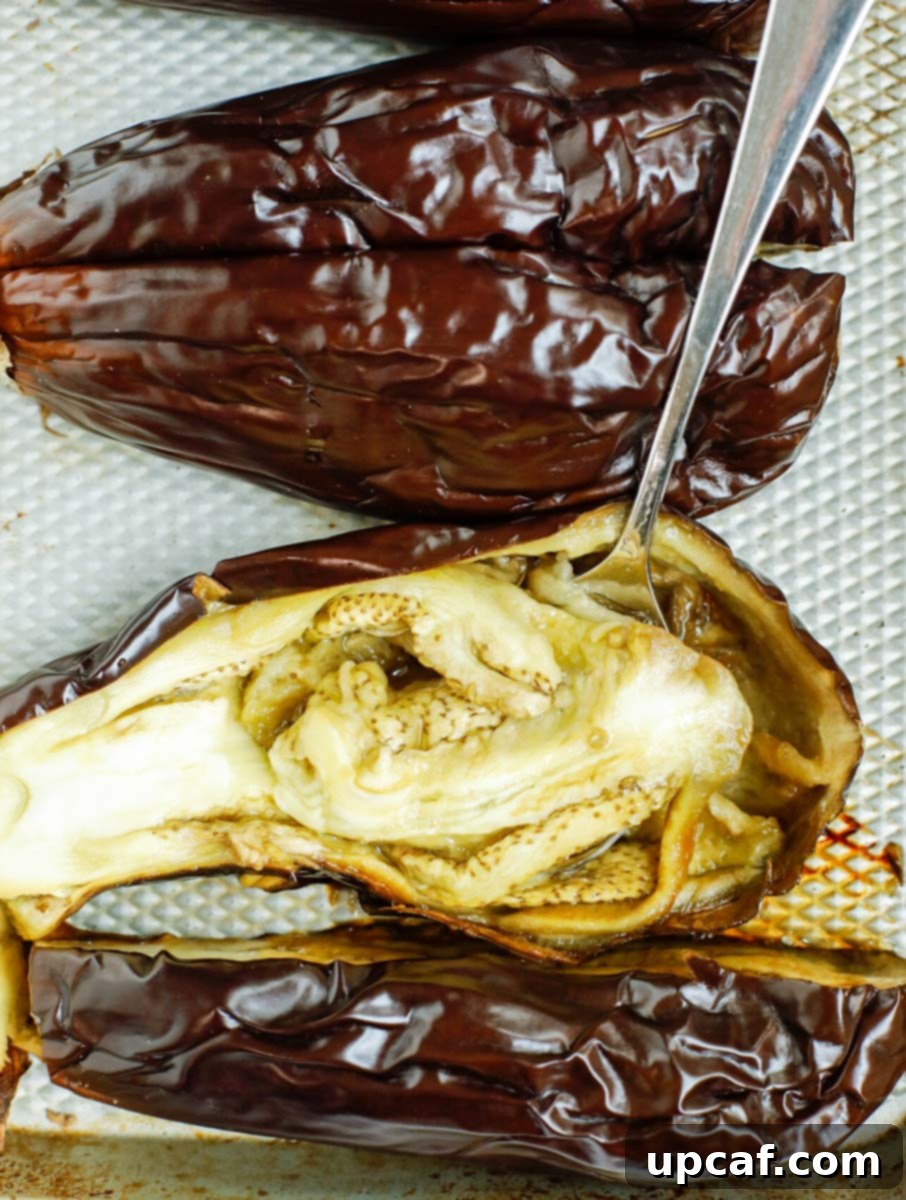
- Step 4: Blending Everything to Perfection: Transfer the scooped eggplant flesh to a food processor. Add the tahini, fresh lemon juice, minced fresh garlic, salt to taste, and the optional liquid smoke. Process the mixture by pulsing only 3-4 times. It is crucial not to over-blend! Unlike hummus, Baba Ganoush is traditionally meant to have a slightly chunky, rustic texture, not a super smooth, homogenous paste. Short pulses will achieve the perfect consistency, allowing some small eggplant fibers to remain.

- Step 5: Garnish and Serve: Transfer your freshly made Baba Ganoush to a shallow serving dish. Using the back of a spoon, create attractive deep grooves or a swirling pattern on the surface. These grooves are not just for aesthetics; they are perfect for holding a generous drizzle of high-quality olive oil. Finish with your preferred garnishing ingredients such as toasted pine nuts for a nutty crunch, finely chopped fresh parsley for a touch of herbaceous freshness, and vibrant pomegranate seeds for a burst of color and sweet-tart flavor. Serve immediately with warm pita bread, fresh vegetables, or as part of a larger mezze platter.
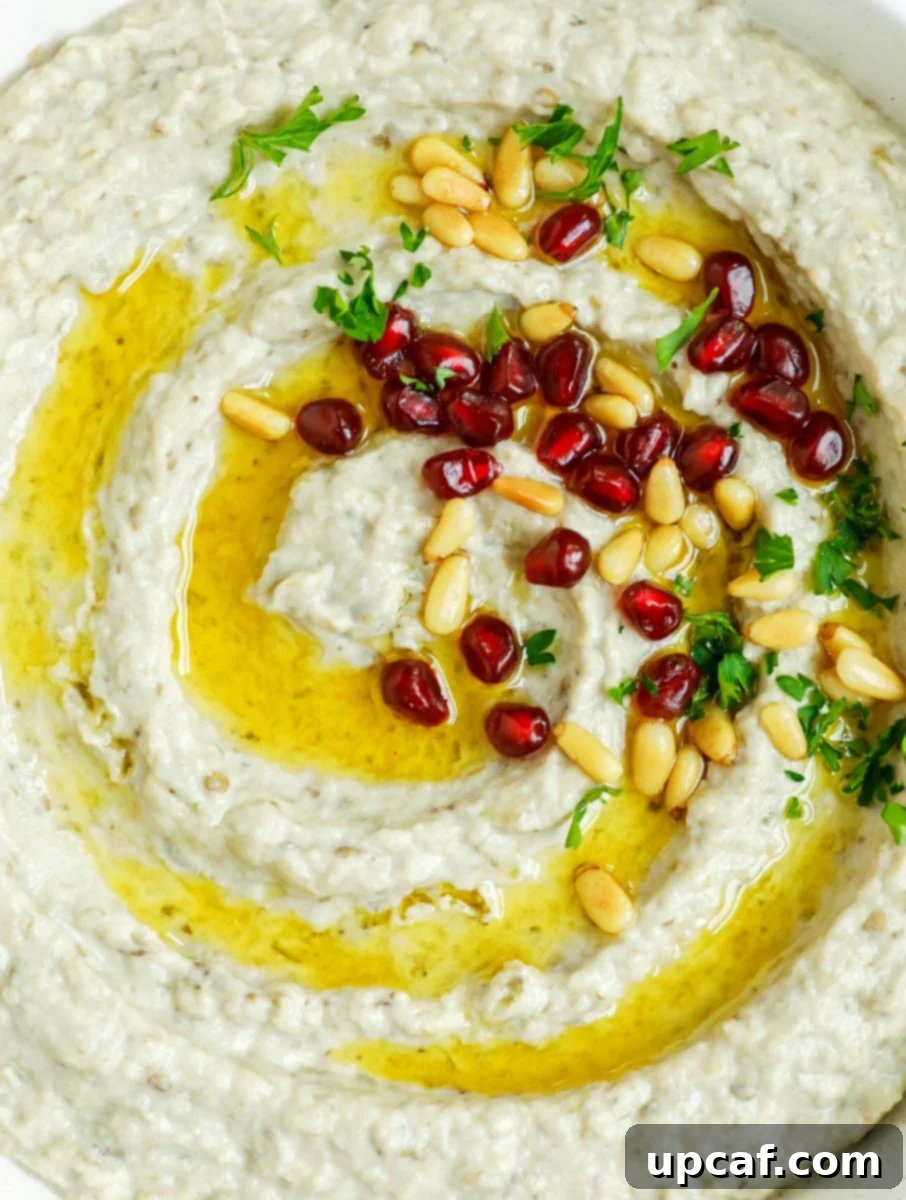
Baba Ganoush: The Traditional Hand-Mashed Method for a Rustic Texture
While a food processor offers convenience, many enthusiasts and traditionalists argue that authentic Baba Ganoush is best when it retains a delightful, slightly chunky texture. This is achieved by hand-mashing rather than machine-blending, which can sometimes over-process the eggplant into too smooth a paste. If you prefer a more rustic, textured dip that truly celebrates the eggplant’s character, follow this traditional method:
- Step 1: Chop or Mash the Eggplant Flesh: After your roasted Baba Ghanouj has cooled completely and you’ve scooped out the tender flesh, transfer it to a large cutting board. Instead of a food processor, use a sharp knife to finely chop the eggplant flesh, working it until it reaches your desired consistency – typically a coarse, slightly chunky mash. Alternatively, you can place the eggplant flesh in a bowl and use a fork or a potato masher to mash it until it’s well broken down but still retains some texture. This manual method allows for greater control over the final consistency. Once mashed, transfer the eggplant to a mixing bowl.

- Step 2: Incorporate Other Ingredients: To the mashed eggplant, add all the remaining ingredients as listed in the main recipe: tahini, fresh lemon juice, minced fresh garlic, salt to taste, and the optional liquid smoke. Using a spoon or spatula, thoroughly mix all the ingredients together until they are well combined and evenly distributed. Taste the mixture and adjust the seasoning as needed, adding more lemon juice, salt, or garlic to achieve your perfect balance of flavors. The mixing process should be gentle enough to maintain the desired chunky texture.
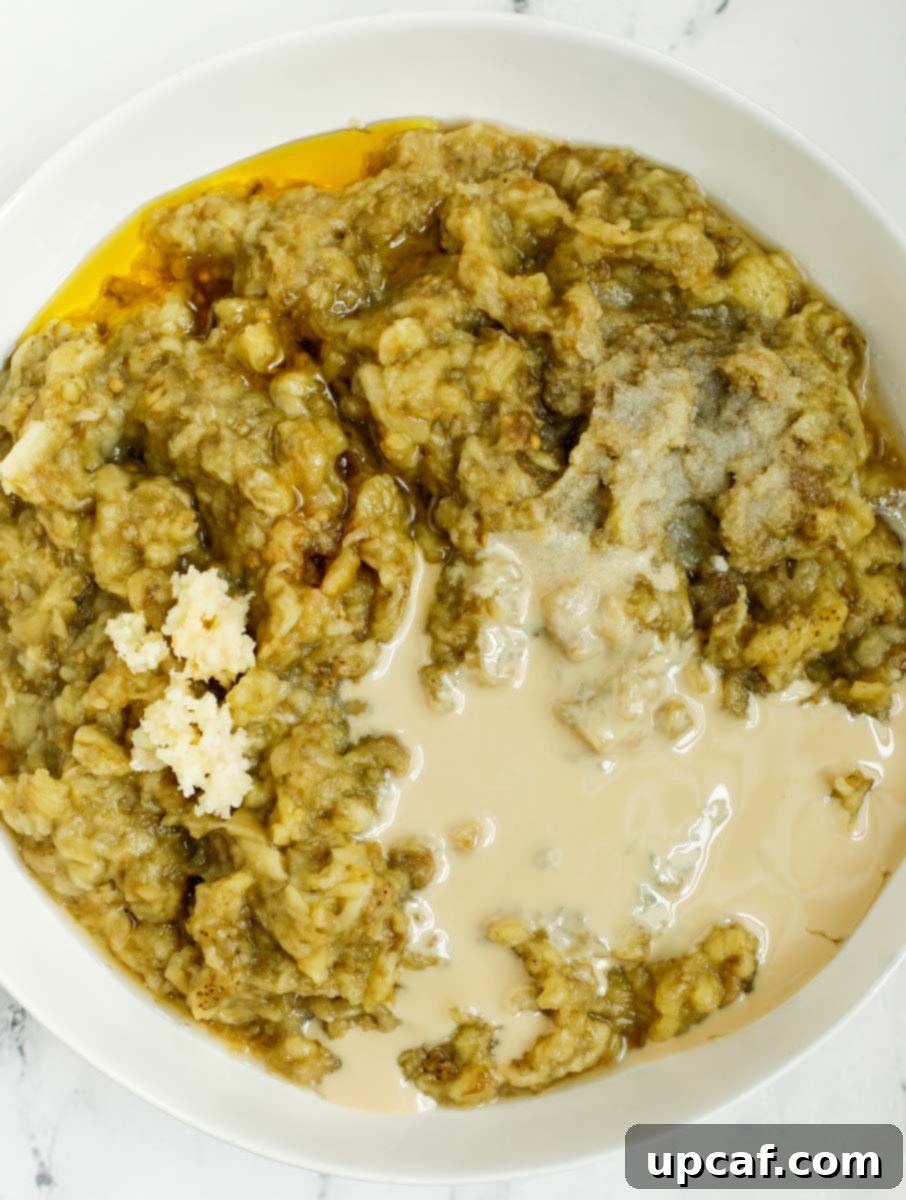
- Step 3: Present and Garnish: Carefully transfer the hand-mashed Baba Ganoush to a shallow serving dish. Just like with the blended version, use the back of a spoon to create attractive deep grooves on the surface. This not only enhances its visual appeal but also creates perfect little pools for the final drizzle of olive oil. Complete your presentation by generously garnishing with traditional toppings such as toasted pine nuts for a delicate crunch, freshly chopped parsley for herbaceous notes, and vibrant pomegranate seeds for a delightful burst of sweetness and color. Serve this rustic, flavorful dip alongside warm pita bread, crisp vegetables, or as a delectable side dish.
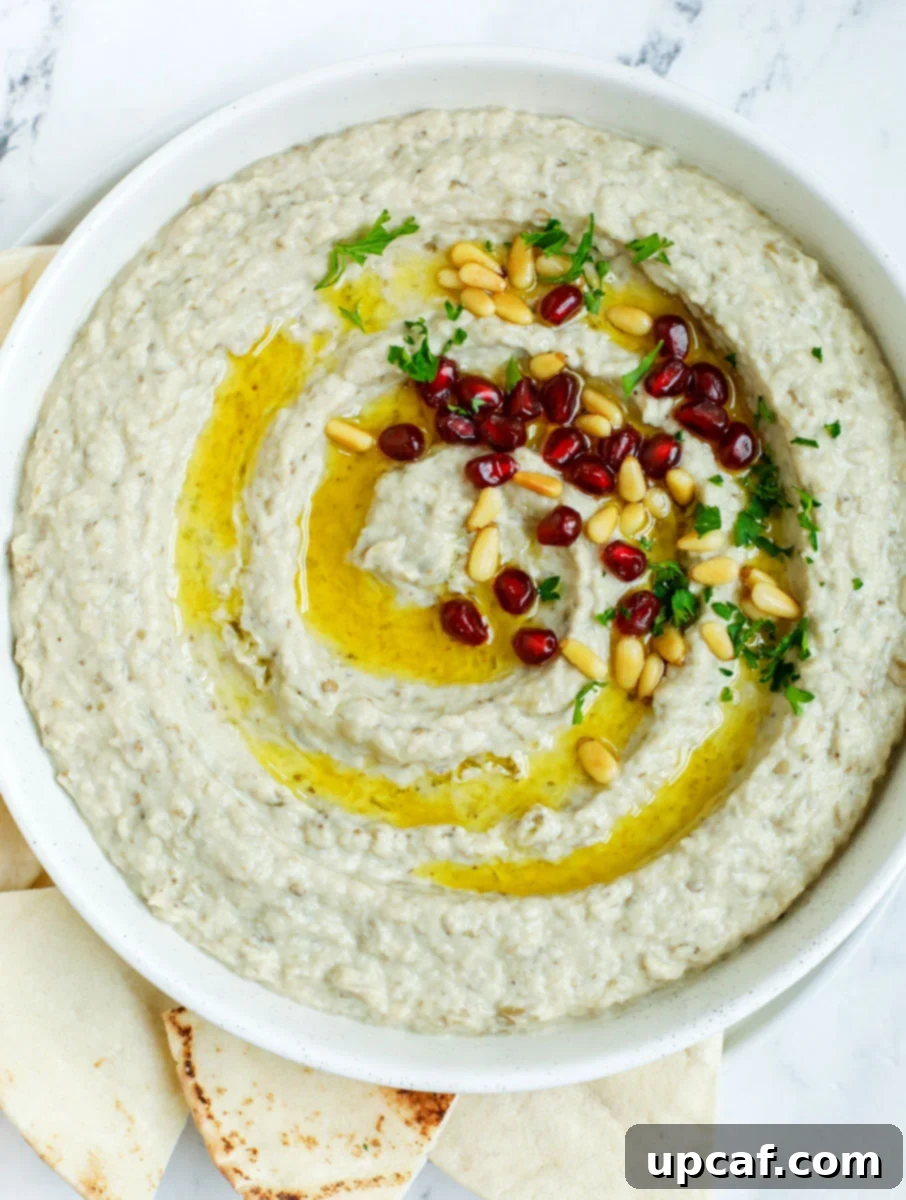
Expert Tips for the Best Homemade Baba Ganoush Dip
Achieving the perfect Baba Ganoush is an art, but these expert tips will guide you to a consistently delicious and authentic dip every time:
- Prioritize Fresh Lemon Juice: This cannot be stressed enough. The vibrant acidity of freshly squeezed lemon juice is paramount. Bottled lemon juice often contains stabilizers and can taste flat or overly processed, which will detract significantly from the bright, fresh flavor profile of your Baba Ganoush. Invest in fresh lemons for an incomparable taste.
- Strain for Optimal Texture: After roasting and cooling, eggplants can hold a surprising amount of water. To prevent your Baba Ganoush from becoming watery or diluted, gently press the scooped eggplant flesh in a fine-mesh sieve or wrap it in a clean cheesecloth and squeeze out any excess moisture. This step ensures a wonderfully creamy and concentrated dip.
- Fresh Garlic Makes a Difference: Just like with lemon juice, fresh garlic is a non-negotiable ingredient. Some brands of pre-minced or bottled garlic are preserved in an acidic liquid, which can introduce an unwanted sharp, bitter, or overpowering taste that will mask the subtle flavors of the eggplant and tahini. Always use fresh garlic cloves, finely minced or crushed, for the best aromatic foundation.
- Adjust Creaminess to Your Liking: If you find your eggplant dip isn’t quite as creamy as you prefer, you have a couple of options. You can simply stir in an additional tablespoon or two of tahini, which will add richness and a smoother consistency. Alternatively, for a slightly different flavor profile and added creaminess, a tablespoon or so of full-fat plain yogurt can be incorporated.
- Embrace the Grill for Authentic Smoke: While oven roasting is convenient and effective, grilling your eggplants over an open flame or charcoal is the traditional method and will impart an unparalleled smoky depth that is hard to replicate. If you have access to a grill, leave the eggplants whole and grill them until the skin is charred and the flesh is completely tender. When grilling, you likely won’t need to add any liquid smoke.
- Avoid Over-Blending: Remember, Baba Ganoush is not meant to be as smooth as hummus. Over-blending in a food processor can turn the dip into a pasty, unappetizing consistency. Pulse only a few times until the ingredients are combined and you have a rustic, slightly chunky texture. If you prefer a completely smooth dip, you can blend longer, but the traditional appeal lies in its texture.
- Chill for Enhanced Flavor: While tempting to serve immediately, allowing your Baba Ganoush to chill in the refrigerator for at least 2 hours (or even overnight) before serving dramatically enhances its flavors. The time allows the ingredients to meld together, deepening the smoky, tangy, and garlicky notes for a more harmonious and delicious experience.
Frequently Asked Questions About Baba Ganoush
When properly stored, your homemade eggplant dip will last for up to a week in the refrigerator. Once the Baba Ganoush has cooled to room temperature after preparation, transfer it to an airtight container. This prevents it from drying out and absorbing other odors in the fridge. For the best flavor and texture, consume within 5-7 days.
Absolutely! Baba Ganoush freezes remarkably well, making it perfect for meal prep or for enjoying later. You can easily double the recipe and freeze half for a quick, delicious dip whenever you need it. I highly recommend freezing it in individual portions in freezer-safe bags or containers. This way, you can thaw only the amount you need, reducing waste. It can be stored in the freezer for up to 3 months. Thaw overnight in the refrigerator before serving, and give it a good stir, adding a fresh drizzle of olive oil if needed.
Baba Ganoush is incredibly versatile and pairs wonderfully with almost anything! Enjoy it as a traditional dip with warm pita bread, crunchy pita chips, or an assortment of fresh vegetables like cucumber sticks, carrot sticks, bell pepper strips, and radishes. It also makes an excellent spread for sandwiches, wraps, and even toast, adding a Mediterranean twist. Serve it as a flavorful side dish with grilled meats such such as chicken or lamb, kebabs, or roasted fish. Don’t limit yourself – its creamy texture and smoky flavor can elevate many meals!
Tahini is a fundamental ingredient in Middle Eastern cuisine, a smooth paste made from finely ground toasted sesame seeds. It has a distinctive nutty, earthy, and slightly bitter flavor, and a creamy texture similar to natural peanut butter. Tahini is a staple in various dishes, most notably hummus and Baba Ganoush, but it’s also used in salad dressings, sauces, and even some baked goods. You can easily find high-quality tahini in most major grocery stores, often in the international aisle or near nut butters.
While tahini is a key ingredient that gives Baba Ganoush its characteristic nutty flavor and creamy texture, you can certainly make a version without it. The result will be an eggplant dip that is still delicious but will have a different flavor profile and likely a less creamy consistency. If omitting tahini, you might consider adding a tablespoon of plain Greek yogurt or a drizzle of extra olive oil to help maintain some creaminess.
Bitterness in Baba Ganoush can typically come from a few sources. Overcooking the eggplant until it’s too charred can contribute to bitterness. Using old or poor-quality tahini can also be a culprit, as tahini naturally has a slight bitterness that becomes more pronounced if stale. Additionally, some eggplants naturally have more bitterness, especially larger, older ones. Ensure you choose fresh, firm eggplants and taste your tahini before adding it to the dip. Adding a bit more fresh lemon juice can sometimes help to balance out any slight bitterness.
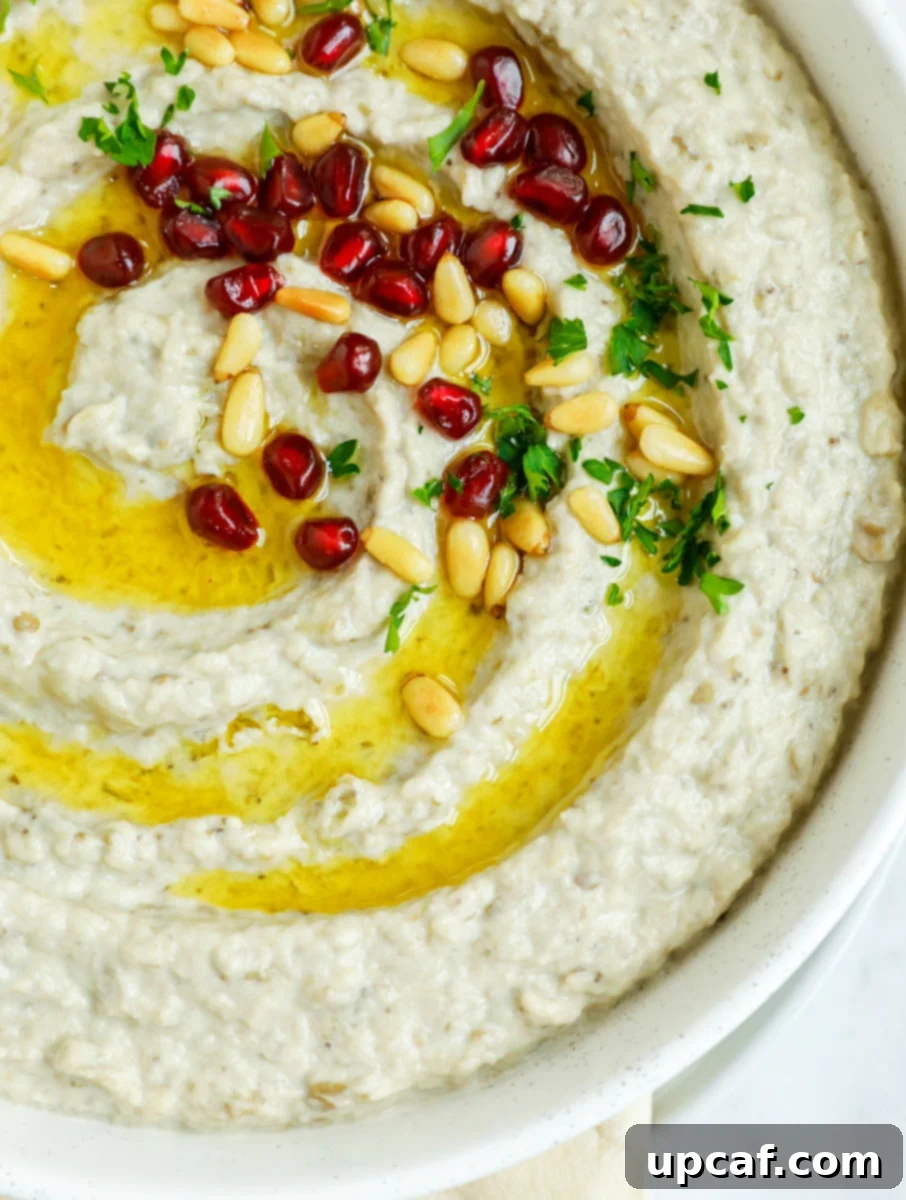
Discover More Easy & Authentic Lebanese Recipes
Embark on a culinary journey through Lebanon with these other fantastic and easy-to-make recipes that capture the essence of Middle Eastern home cooking:
- Maamoul Date Cookies – Delicate shortbread cookies filled with a rich date paste, perfect with coffee.
- Maghmour (Lebanese Moussaka) – A delicious vegetarian stew layered with eggplant, chickpeas, and a flavorful tomato sauce.
- Lebanese Spicy Potatoes (Batata Harra) – Crispy, spicy potato cubes flavored with garlic, cilantro, and chili.
- Easy Beef Shawarma Bowl – All the delicious flavors of traditional beef shawarma, deconstructed into a healthy bowl.
- Lebanese Meat Pies – Savory pastries filled with seasoned ground meat, a beloved snack or appetizer.
I genuinely hope you find immense pleasure in all the recipes I share with you, and especially in this incredibly delicious Lebanese Baba Ganoush recipe. There’s a special satisfaction in creating such a vibrant and flavorful dip from scratch, far superior to any store-bought alternative. I encourage you to try this recipe in your own kitchen; I’m confident you’ll enjoy it immensely. Please consider leaving a star rating and a comment below once you’ve made it, and don’t hesitate to share this delightful recipe with your friends and family!
If this recipe becomes a favorite, I would be thrilled if you could leave a star rating and a comment below to share your experience. Additionally, follow me at Cookin’ With Mima on FACEBOOK |INSTAGRAM |PINTEREST to stay updated on all my latest social posts, culinary adventures, and newest recipes.

Lebanese Baba Ganoush
Ingredients
- 3 large Eggplants
- ½ cup Tahini
- 1 tbsp. olive oil
- 1 whole Lemon, squeezed
- 2 cloves Fresh Garlic, minced
- 3-4 drops liquid smoke, adjust to preference, optional
- Salt to taste
Toppings
- Toasted Pine nuts
- Chopped Parsley
- Pomegranate Seeds
Instructions
- Preheat the oven to 425° F degrees (220°C).
- Poke the eggplants in a few places with a knife or fork to allow steam to escape, then place them onto a non-stick sheet pan.
- Bake the eggplants for 40-45 minutes, or until they are completely fork-tender and the skin is slightly charred. Remove them from the oven, cut them in half lengthwise as shown in the photos, and allow them to cool completely to room temperature. This step is crucial for flavor and texture.
- Once the eggplants are cool, scoop out the tender flesh and transfer it to a food processor. Add in the remainder of the ingredients: tahini, fresh lemon juice, minced garlic, salt, and the optional liquid smoke. Pulse the mixture only 3-4 times at most. Be careful not to over-process, as Baba Ganoush is traditionally meant to have a slightly chunky, rustic texture, not a super smooth one like hummus.
- Transfer the blended mixture to a shallow serving dish. Using the back of your spoon, shape the Baba Ganoush and create deep grooves on the surface. These grooves are perfect for holding a generous drizzle of high-quality olive oil. Finish by garnishing with the suggested toppings: toasted pine nuts for crunch, chopped fresh parsley for freshness, and vibrant pomegranate seeds for a burst of color and sweet-tartness. Serve immediately with warm pita bread, fresh vegetables, or as a flavorful side alongside your favorite main dishes.
Notes
- It is important that you use fresh lemon juice and not bottled lemon juice for the best flavor.
- Consider straining the roasted eggplant flesh to remove any excess moisture for a creamier, less watery dip.
- Fresh garlic is also an important ingredient for its pungent flavor. Avoid bottled minced garlic, as its acidic preservation liquid can overpower your Baba Ganoush.
- If you’d like your eggplant dip to be a little creamier, you can stir in an additional tablespoon of tahini or a tablespoon or so of full-fat plain yogurt.
- If you have a grill, you can grill your eggplants instead of roasting them in the oven. Grill them whole until charred and tender, and you won’t need to add any liquid smoke.
- Do not over-blend the mixture; Baba Ganoush should have a slightly chunky texture, not be super smooth. Allowing the dip to chill in the fridge for at least 2 hours before serving will significantly enhance its flavors.
Nutrition
Like this recipe? Rate and comment below!
